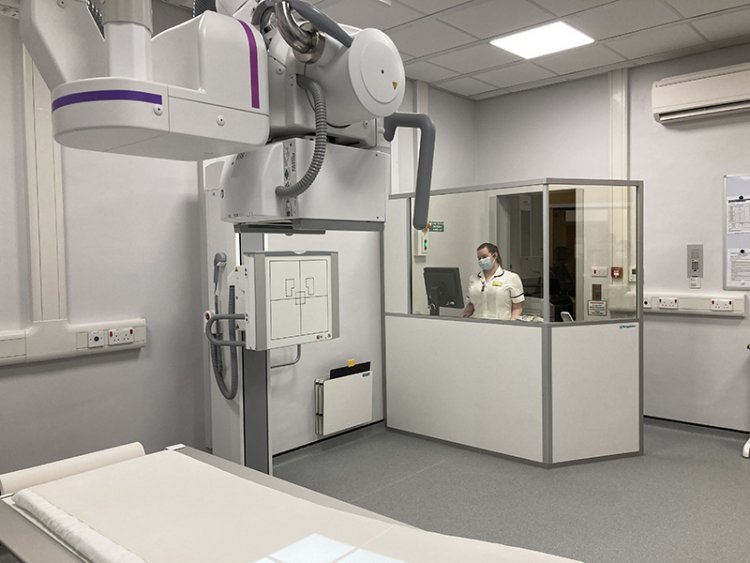The Advanced Materials and Processes Research Institute (AMPRI) in Bhopal makes X-ray shielding tiles out of red mud.
It is possible to construct radiation shielding structures using the tiles in diagnostic X-rays, CT scanner rooms, catheterization laboratories, bone mineral density imaging, and dental X-rays, among other applications.

Through the use of a ceramic process, researchers at the CSIR-Advanced Materials and Processes Research Institute (AMPRI) were able to turn red mud into X-ray shielding tiles in an environmentally friendly and economically viable manner. This was accomplished by combining the red mud with a certain weight percentage of high Z material and a binder. At a voltage of 100 kV, the 12 mm thick tiles have an attenuation that is equivalent to 2.1 mm of lead. In addition to this, the tile that was produced has a flexural strength of 34 N/mm2 and a breaking strength of 3369 N. As an alternative to the hazardous lead sheet, these tiles can be used to construct radiation shielding structures in diagnostic X-rays, CT scanner rooms, Cath labs, bone mineral density, and dental X-rays, among other imaging procedures, in order to protect the general public from the dangers posed by radiation.
Today, at the Directors' conference that was held in Palampur, the Director General of the Council for Scientific and Industrial Research (CSIR) and the Secretary of the Department of Scientific and Industrial Research (DSIR) for the Government of India, Dr. N. Kalaiselvi, released the first flyer of the brochure that details the success story of the topic, beginning with fundamental research and moving on to applied research, commercialization to M/S Prism Johnson, and deployment of the technology.
On April 10, 2019, at CSIR in New Delhi, the know-how for the production of "Lead-Free X-ray Shielding Tiles" was passed to M/S Prism Johnson Ltd. Joint-free X-ray shielding tiles with dimensions of 30 by 30 by 1.2 centimetres cubed were manufactured on a pilot scale on April 14, 2022 by CSIR-AMPRI in collaboration with M/s Prism Johnson Ltd. after a collaborative effort to scale up this technology from the laboratory to the industrial level. The Atomic Energy Regulatory Board of India (AERB) has evaluated the newly designed tiles and given its stamp of approval on them. The product is now available for purchase, and the first instalment has already begun at INS Kattabomman in the state of Tamil Nadu.
The manufacturing of alumina from bauxite via the Bayer method results in the generation of trash known as "red mud." Bauxite residue is another name for this substance. A "High Volume Low Effect Waste" is what the term "Red Mud" refers to. When using the Bayer method to extract alumina from bauxite ore, around 0.9 to 1.3 metric tonnes of RM waste are produced for every tonne of alumina that is produced. Because of its extremely high alkalinity and the heavy elements that it leaches out, it is regarded to be poisonous. About 175 million metric tonnes of red mud are produced each year all over the world and stored in a pond that has been lined with clay and was specifically created for the purpose. Among these, India is responsible for the annual production of around 9 million tonnes of red mud. Clay-lined ponds frequently burst their dams, which polluted the surrounding land, groundwater, and air, leading to the death of both humans and wildlife.
Due to an increase in alumina production as well as a lack of sufficient technology for its large-scale application, red mud is one of the underutilised industrial wastes that has been accumulating over the years. This is one of the reasons why red mud is considered a waste. Although the scientific community has patented more than 700 different uses for red mud, very few of these applications have made it into industry due to factors such as high cost, low public acceptance, environmental concerns, and limited market. Notable is the fact that only three to four percent of red mud has been utilised by industries to produce cement, bricks, source of iron ore, etc., (i.e. one to one and a half to one million tonnes (Mt) for cement production, 0.2–1.2 Mt for iron production and 0.5–1.0 Mt for building materials and 0.3 Mt for making pigments, catalyst, ceramics, and other such things). The productive application of red mud is evolving into a topic of concern on a global scale. The red mud has between 30 and 55% of the element Fe2O3, which makes it an excellent material for dampening the effects of high-energy ionising radiation such as X- and gamma-rays.
What's Your Reaction?




















